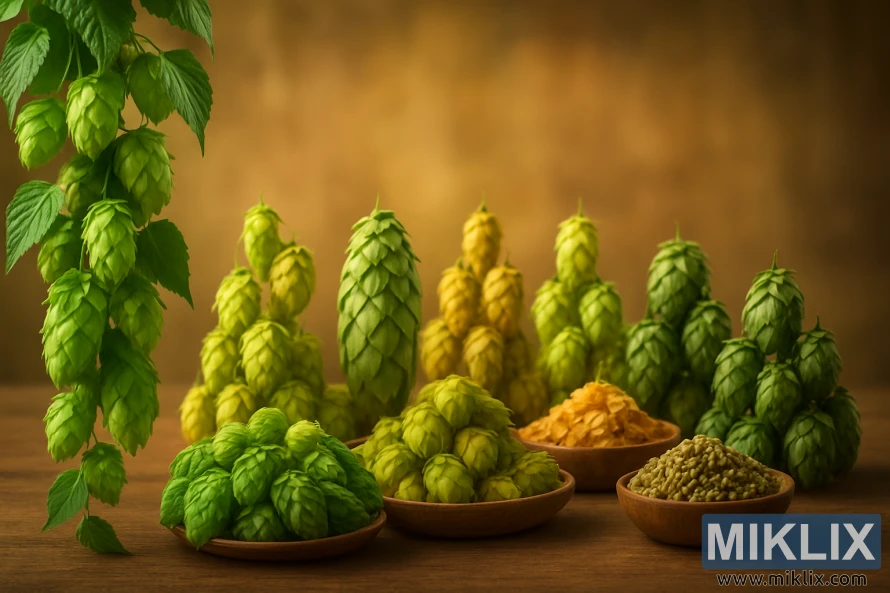Image: Display of Riwaka and Complementary Hop Varieties
Published: October 22, 2025 at 9:50:40 PM UTC
A vibrant still life showcases Riwaka hops alongside complementary hop varieties. Cascading green cones, golden cultivars, and diverse preparations highlight the harmony and versatility of hops in craft brewing.
The photograph presents a vibrant and carefully staged display of hop varieties, arranged to highlight both their natural beauty and their significance in brewing. In the foreground, lush green hop cones cascade downward from a bine, their overlapping bracts forming intricate, scaled patterns that glisten subtly under the warm, diffused lighting. The cones, plump and fresh, command immediate attention with their vibrant color and delicate structure, symbolizing the aromatic heart of brewing. Their tendrils intertwine gracefully, adding a sense of organic movement to the otherwise still composition.
Just beyond the foreground, an array of hop cultivars rises proudly in the middle ground, each grouping distinct yet complementary. Some cones display the bright lime-green freshness typical of newly harvested hops, while others shift toward golden hues, suggesting subtle differences in oil content, aroma, and bitterness. The cones are stacked in small mounds and arranged in neat clusters, their shapes and tones varying slightly to emphasize diversity. Together, they form a chorus of varietals, reflecting the wide spectrum of flavor and aroma profiles brewers may select to pair with or enhance the unique qualities of Riwaka hops.
Wooden bowls at the base of the scene contain different hop preparations and additional cultivars, showcasing the versatility of the ingredient. Pale green cones nestle side by side with slightly yellower hops, while another bowl holds finely flaked material in an amber hue, perhaps dried or processed hops meant for brewing experiments. A separate vessel contains pelletized hops, their compact form a reminder of the many ways brewers prepare and handle these ingredients for maximum efficiency and consistency. This interplay of form—whole cone, flaked, pellet—reinforces the multifaceted role hops play in modern brewing.
The background dissolves into a hazy, golden-brown environment, softly blurred to evoke the earthy warmth of a brewery at golden hour. The light cascading through the scene is gentle and diffused, casting a glow that enhances the rich greens and yellows of the hops while creating an atmosphere of calm focus. Shadows are soft and unobtrusive, allowing the cones’ delicate details to stand out against the muted backdrop. The interplay of texture—the smooth wooden bowls, the layered hop bracts, the blurred warmth behind—gives the image depth and richness.
This still life does more than showcase ingredients: it tells a story of balance and harmony. At its center is the Riwaka hop, celebrated for its bright tropical fruit notes and its ability to elevate beer with vivid aromatics. Surrounding it are complementary cultivars, representing the brewer’s palette of flavors and aromas. The photograph celebrates the versatility of Riwaka while acknowledging the art of blending—how brewers pair different hop varieties to achieve complexity, balance, and distinction in their beers.
The overall atmosphere is serene and inviting, a portrait of brewing tradition and innovation. It bridges agriculture and artistry, raw materials and finished product. The composition conveys respect for the natural beauty of hops while also highlighting the thoughtful craftsmanship that transforms them into the soul of craft beer.
The image is related to: Hops in Beer Brewing: Riwaka

